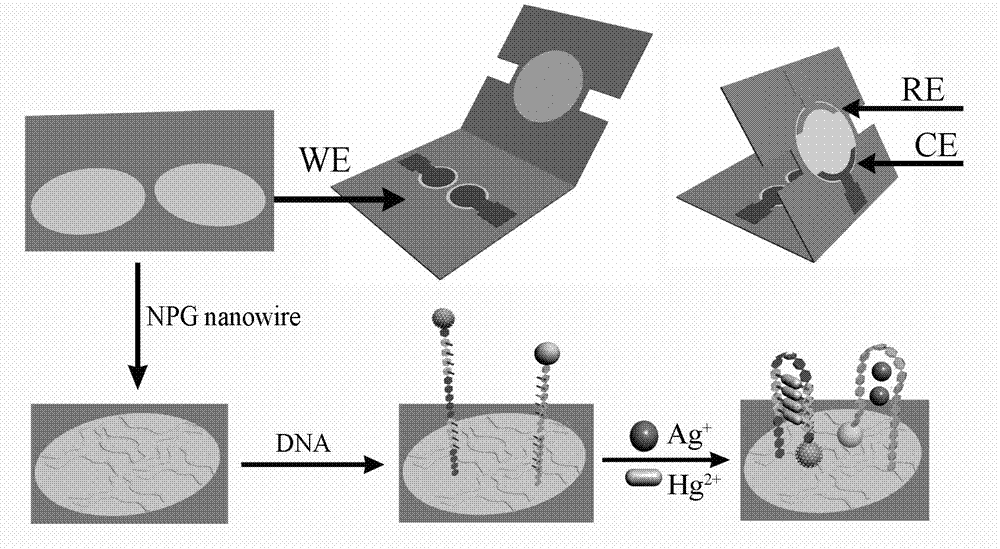Preparation of ECL (electro chemical luminescence) DNA (Deoxyribose Nucleic Acid) sensor based on 3D paper chip, and application of sensor to simultaneous detection on Hg<2+> and Ag<+>
An electrochemical and sensor technology, applied in the field of trace heavy metal ion detection, can solve the problems of expensive reagents, easy to be polluted, and limited maximum detection limit.
- Summary
- Abstract
- Description
- Claims
- Application Information
AI Technical Summary
Problems solved by technology
Method used
Image
Examples
Embodiment 1
[0039] Example 1 (Tap water testing)
[0040] Preparation of a 3D paper chip-based ECL DNA sensor and its simultaneous detection of Hg 2+ 、Ag + method, including the following steps:
[0041] (1) Take 10 mL of tap water used in daily life as the sample to be tested.
[0042] (2) Design the printing pattern of the hydrophobic area of the microfluidic paper chip on the computer, use screen printing technology to print the working electrode, reference electrode, and counter electrode to the area matching the hydrophobic area, and place the prepared filter paper on the In the heater, heat at 90 °C for 2 min, and then cut the entire filter paper according to the wax-printed pattern to obtain a single microfluidic 3D paper chip ECL sensor.
[0043] (3) Preparation of porous gold nanowires: the Au 0.18 Ag 0.82 As for alloy nanowires on a chip carrier, dilute HNO with a volume fraction of 25% 3 The solution was added dropwise, corroded for 5 min, rinsed with secondary water, a...
Embodiment 2
[0051] Example 2 (Detection of mineral water)
[0052] Preparation of a 3D paper chip-based ECL DNA sensor and its simultaneous detection of Hg 2+ 、Ag + method, including the following steps:
[0053] (1) Take 10 mL of Nongfu mountain spring water purchased from a supermarket as the sample to be tested.
[0054] (2) Design the printing pattern of the hydrophobic area of the microfluidic paper chip on the computer, use screen printing technology to print the working electrode, reference electrode, and counter electrode to the area matching the hydrophobic area, and place the prepared filter paper on the In the heater, heat at 90 °C for 2 min, and then cut the entire filter paper according to the wax-printed pattern to obtain a single microfluidic 3D paper chip ECL sensor.
[0055] (3) Preparation of porous gold nanowires: the Au 0.18 Ag 0.82 As for alloy nanowires on a chip carrier, dilute HNO with a volume fraction of 25% 3 The solution was added dropwise, corroded ...
Embodiment 3
[0063] Example 3 (measurement of blood)
[0064] Preparation of a 3D paper chip-based ECL DNA sensor and its simultaneous detection of Hg 2+ 、Ag + method, including the following steps:
[0065] (1) Take 2 mL of patient serum obtained from the Cancer Hospital as the sample to be tested, and dilute the serum 10 times for detection.
[0066] (2) Design the printing pattern of the hydrophobic area of the microfluidic paper chip on the computer, use screen printing technology to print the working electrode, reference electrode, and counter electrode to the area matching the hydrophobic area, and place the prepared filter paper on the In the heater, heat at 90 °C for 2 min, and then cut the entire filter paper according to the wax-printed pattern to obtain a single microfluidic 3D paper chip ECL sensor.
[0067] (3) Preparation of porous gold nanowires: the Au 0.18 Ag 0.82 As for alloy nanowires on a chip carrier, dilute HNO with a volume fraction of 25% 3 The solution was...
PUM
 Login to View More
Login to View More Abstract
Description
Claims
Application Information
 Login to View More
Login to View More - R&D
- Intellectual Property
- Life Sciences
- Materials
- Tech Scout
- Unparalleled Data Quality
- Higher Quality Content
- 60% Fewer Hallucinations
Browse by: Latest US Patents, China's latest patents, Technical Efficacy Thesaurus, Application Domain, Technology Topic, Popular Technical Reports.
© 2025 PatSnap. All rights reserved.Legal|Privacy policy|Modern Slavery Act Transparency Statement|Sitemap|About US| Contact US: help@patsnap.com

